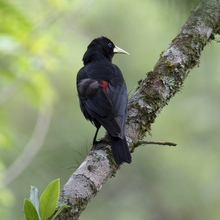| Red-rumped cacique | |
|---|---|

| |
| Conservation status | |
 Least Concern (IUCN 3.1) | |
| Scientific classification | |
| Domain: | Eukaryota |
| Kingdom: | Animalia |
| Phylum: | Chordata |
| Class: | Aves |
| Order: | Passeriformes |
| Family: | Icteridae |
| Genus: | Cacicus |
| Species: | C. haemorrhous |
| Binomial name | |
| Cacicus haemorrhous (Linnaeus, 1766) | |

| |
| Synonyms | |
|
Oriolus haemorrhous Linnaeus, 1766 | |
The red-rumped cacique (Cacicus haemorrhous) is a species of bird in the family Icteridae. It is a species of the Amazon Basin and the Guyanas in northern South America, and is only coastal there in the Guyanas and the Amazon River outlet to the Atlantic; a separate large disjunct range exists in all of south-eastern and coastal Brazil, including Paraguay, and parts of north-eastern Argentina. It is also found in Bolivia, Brazil, Colombia, Ecuador, French Guiana, Guyana, Peru, Suriname, and Venezuela.
The red-rumped cacique's natural habitats are subtropical or tropical moist lowland forests, subtropical or tropical swamps, and heavily degraded former forest.
In 1760 the French zoologist Mathurin Jacques Brisson included a description of the red-rumped cacique in his Ornithologie based on a specimen collected in Cayenne in French Guiana. He used the French name Le cassique rouge and the Latin name Cassicus ruber. Although Brisson coined Latin names, these do not conform to the binomial system and are not recognised by the International Commission on Zoological Nomenclature. When in 1766 the Swedish naturalist Carl Linnaeus updated his Systema Naturae for the twelfth edition, he added 240 species that had been previously described by Brisson. One of these was the red-rumped cacique. Linnaeus included a brief description, coined the binomial name Oriolus haemorrhous and cited Brisson's work. The specific name haemorrhous combines the Ancient Greek words haima "blood" and orrhos "rump". The red-rumped cacique is now the type species in the genus Cacicus that introduced by the French naturalist Bernard Germain de Lacépède in 1799.
References
- BirdLife International (2016). "Cacicus haemorrhous". IUCN Red List of Threatened Species. 2016: e.T22724034A94845903. doi:10.2305/IUCN.UK.2016-3.RLTS.T22724034A94845903.en. Retrieved 11 November 2021.
- Brisson, Mathurin Jacques (1760). Ornithologie, ou, Méthode contenant la division des oiseaux en ordres, sections, genres, especes & leurs variétés (in French and Latin). Vol. 2. Paris: Jean-Baptiste Bauche. pp. 98–100, Plate 8 fig 2. The two stars (**) at the start of the section indicates that Brisson based his description on the examination of a specimen.
- ^ Allen, J.A. (1910). "Collation of Brisson's genera of birds with those of Linnaeus". Bulletin of the American Museum of Natural History. 28: 317–335. hdl:2246/678.
- Linnaeus, Carl (1766). Systema naturae : per regna tria natura, secundum classes, ordines, genera, species, cum characteribus, differentiis, synonymis, locis (in Latin). Vol. 1, Part 1 (12th ed.). Holmiae (Stockholm): Laurentii Salvii. p. 161.
- Jobling, J.A. (2018). del Hoyo, J.; Elliott, A.; Sargatal, J.; Christie, D.A.; de Juana, E. (eds.). "Key to Scientific Names in Ornithology". Handbook of the Birds of the World Alive. Lynx Edicions. Retrieved 1 May 2018.
- Lacépède, Bernard Germain de (1799). "Tableau des sous-classes, divisions, sous-division, ordres et genres des oiseux". Discours d'ouverture et de clôture du cours d'histoire naturelle (in French). Paris: Plassan. p. 6. Page numbering starts at one for each of the three sections.
- Paynter, Raymond A. Jr, ed. (1968). Check-list of birds of the world. Vol. 14. Cambridge, Massachusetts: Museum of Comparative Zoology. p. 144.
External links
- Red-rumped cacique videos - Internet Bird Collection
- Stamps (for Suriname) with range map – (shows disjunct range on south-east coastal Brazil)
- Red-rumped cacique photo gallery - VIREO Photo-High Res
- Photo; Article-(High Res: photo gallery: Nest, preening, Surinam map, etc.) - https://www.nhlstenden.com/
| Taxon identifiers | |
|---|---|
| Cacicus haemorrhous |
|
| Oriolus haemorrhous | |